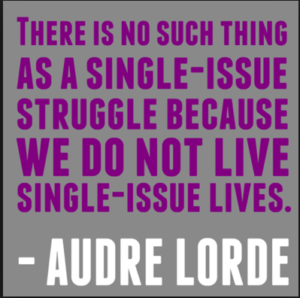 Sexual violence impacts everyone and all aspects of a survivor’s life.CALCASA recognizes and seeks to center an intersectional approach to ending sexual violence. So far, we have covered the intersections of faith-based communities, transformative justice, and health and wellness.
Sexual violence impacts everyone and all aspects of a survivor’s life.CALCASA recognizes and seeks to center an intersectional approach to ending sexual violence. So far, we have covered the intersections of faith-based communities, transformative justice, and health and wellness.
This blog briefly discusses the importance of looking at racial justice in the context of sexual violence and provides some steps for an intersectional approach, because then, we are able to see the whole person rather than a symptom, incident, or circumstance of what happened to them.
A prime example of why we should include an intersectional focus of racial justice when working with sexual assault victims is the powerful campaign, #StandWithHer. The campaign was created by the Black Women’s Blueprint as a response to the Daniel Holtzclaw rape case. Holtzclaw was found guilty of assaulting or raping 13 black women as an Oklahoma police officer. The survivors of his assaults were historically people from the margins, had criminal histories of drug use and prostitution, came from one of Oklahoma’s poorest neighborhoods and ranged from ages 17 to their 50s.
The Black Women’s Blueprint recognized the importance of standing in solidarity with the women survivors at Holtzclaw’s sentencing. As the Black Women’s Blueprint stated, “the generally accepted notion of justice by the mainstream, rarely ever resonates with Black women and girls. It has not delivered for Black women, other women of color, girls, or trans folks, the security promised, nor their civil and human rights.” The act of standing in solidarity with the women survivors centered their experiences and identities within an oppressive system that historically re-traumatizes and dismisses “women of color, girls, or trans folks”.
“He didn’t choose CEOs or soccer moms; he chose women he could count on not telling what he was doing,” prosecutor Lori McConnell said during closing arguments, according to the news agency Reuters. “He counted on the fact no one would believe them and no one would care.”
So how do we dismantle oppression as we focus on racial justice to end sexual violence? We believe that advocates should first focus on these three steps to creating an intersectional approach to ending sexual violence. To be clear, this is not an exhaustive list of what to do, but a place to start.
- Have transformative conversations on what dismantling oppression looks like in your community, organization, and groups. Oppression is the “use of power to disempower, marginalize, and silence one social group or an individual.” If we are dismantling oppression, we are disengaging the systems that make survivors vulnerable to retraumatization. Organize space for meaningful discussions on oppression, racism, sexism, and gender-based violence.
- Recognizing intersectionality. Intersectionality is a concept that was developed by Kimberle Crenshaw to address experiences of multiple levels of social injustice. For example, a survivor who is a sexual assault victim that has a disability, identifies as genderfluid, and is a person of color may experience multiple oppressions due to these identities. When we recognize the frame of intersectionality, we can provide a more empowering approach to their traumatic experience. Check out Kimberle Crenshaw’s TEDTalk, “The Urgency of Intersectionality.”
- In order to achieve our goal of dismantling oppression, we need meaningful allyship. According to the Anti-Oppression Network, allyship is an active, consistent, and arduous practice of unlearning and re-evaluating, in which a person of privilege seeks to operate in solidarity with a marginalized group of people. While in this process, find and work with your allies to collaborate, cooperate, and work towards a shared mission that is rooted in anti-racist, anti-sexist, and anti-violence work. Visit the Anti-Oppression website to learn more about allyship.
As our movement grows and shifts, we must continue to have these transformative conversations about racial justice that will fundamentally alter the way in which we do our anti-sexual violence work. We must take a stand against oppression and an intersectional frame will get us there. Organizations across the country are disrupting the status quo by dismantling oppression, recognizing intersectionality, and engaging allies to ultimately end sexual violence.
Links to resources:
Kimberle Crenshaw Tedtalk, “The Urgency of Intersectionality”
https://www.ted.com/talks/kimberle_crenshaw_the_urgency_of_intersectionality
Anti-Oppression Network
https://theantioppressionnetwork.wordpress.com/
Anti-Oppression Network – allyship
https://theantioppressionnetwork.wordpress.com/allyship/
Anti-Oppression Network – what is anti-oppression
https://theantioppressionnetwork.wordpress.com/what-is-anti-oppression/
Black Women’s Blue Print
http://www.blackwomensblueprint.org/
Co- Authored by:

